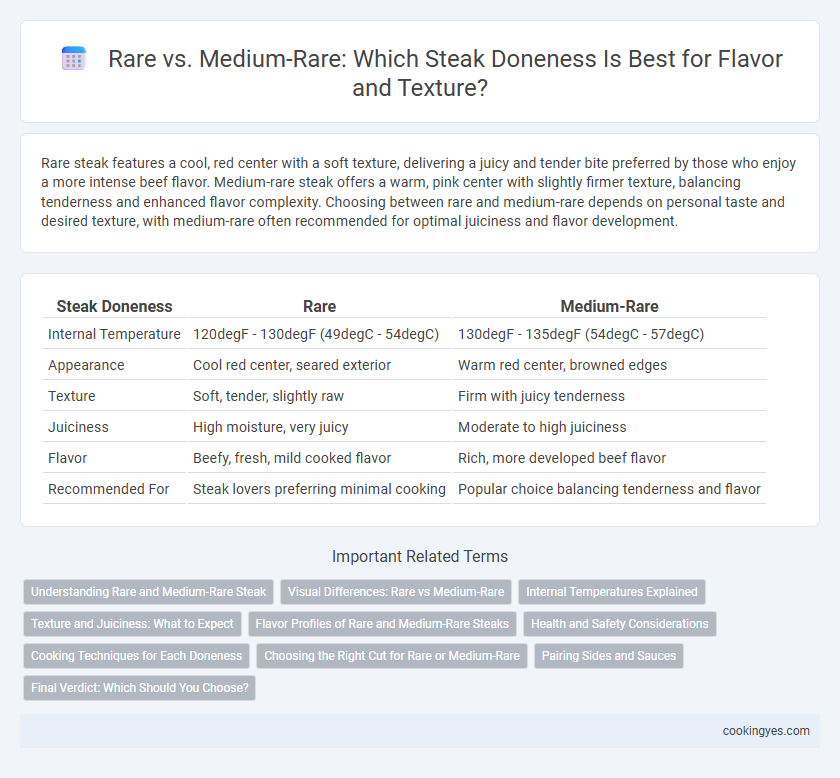Rare steak features a cool, red center with a soft texture, delivering a juicy and tender bite preferred by those who enjoy a more intense beef flavor. Medium-rare steak offers a warm, pink center with slightly firmer texture, balancing tenderness and enhanced flavor complexity. Choosing between rare and medium-rare depends on personal taste and desired texture, with medium-rare often recommended for optimal juiciness and flavor development.
Table of Comparison
| Steak Doneness | Rare | Medium-Rare |
|---|---|---|
| Internal Temperature | 120degF - 130degF (49degC - 54degC) | 130degF - 135degF (54degC - 57degC) |
| Appearance | Cool red center, seared exterior | Warm red center, browned edges |
| Texture | Soft, tender, slightly raw | Firm with juicy tenderness |
| Juiciness | High moisture, very juicy | Moderate to high juiciness |
| Flavor | Beefy, fresh, mild cooked flavor | Rich, more developed beef flavor |
| Recommended For | Steak lovers preferring minimal cooking | Popular choice balancing tenderness and flavor |
Understanding Rare and Medium-Rare Steak
Rare steak features a cool, red center with a tender, juicy texture, typically cooked to an internal temperature of 120-125degF (49-52degC). Medium-rare steak offers a warm, pink center with a slightly firmer texture, reaching an internal temperature of 130-135degF (54-57degC). Understanding these doneness levels helps achieve the desired balance between tenderness and flavor for optimal steak enjoyment.
Visual Differences: Rare vs Medium-Rare
Rare steak has a cool, bright red center with a soft, slightly wet texture, while medium-rare features a warm, pink to red center with a firmer consistency. The exterior crust of both doneness levels is seared, but medium-rare steaks display a more pronounced gradient of color transitioning from the edge to the center. Juices in rare steaks appear more red and vivid, whereas medium-rare steaks release slightly clearer, pink-tinted juices when cut.
Internal Temperatures Explained
Rare steak achieves an internal temperature of 120-125degF (49-52degC), resulting in a cool, red center with a soft texture. Medium-rare steak is cooked to an internal temperature of 130-135degF (54-57degC), producing a warm, pink center and slightly firmer texture. These temperature differences impact flavor intensity and juiciness, with medium-rare offering a more balanced taste profile preferred by many steak enthusiasts.
Texture and Juiciness: What to Expect
Rare steak offers a soft, tender texture with a cool, red center that retains maximum juiciness and beefy flavor. Medium-rare steak provides a slightly firmer texture, showcasing a warm, pink center with balanced moisture and enhanced tenderness. Both doneness levels emphasize optimal juiciness, but medium-rare delivers a richer mouthfeel with more pronounced flavor development.
Flavor Profiles of Rare and Medium-Rare Steaks
Rare steaks feature a cool, red center with a tender, juicy texture that highlights the beef's natural, bold flavor and subtle iron notes. Medium-rare steaks offer a warm, pink center with a slightly firmer texture, balancing rich, beefy taste and enhanced caramelization from the Maillard reaction. The flavor profile of medium-rare steaks tends to be more complex and savory compared to the lighter, more delicate flavors found in rare cuts.
Health and Safety Considerations
Rare steak retains a deep red center with minimal cooking, posing a higher risk of harmful bacteria like E. coli if not sourced from high-quality, fresh meat. Medium-rare steak, cooked to an internal temperature of 130-135degF (54-57degC), offers a balance by reducing bacterial risks while maintaining tenderness and juiciness. Ensuring proper handling and cooking to recommended temperatures enhances safety without compromising the flavor and texture preferred by many steak enthusiasts.
Cooking Techniques for Each Doneness
Rare steak requires high heat and a quick sear, typically cooking at 120-130degF (49-54degC) to retain a cool, red center, using techniques like pan-searing or grilling for about 2-3 minutes per side. Medium-rare steak reaches 130-135degF (54-57degC) with a slightly longer cooking time, around 3-4 minutes per side, allowing the center to become warm and pink while still juicy, often achieved through reverse searing or sous vide followed by a brief sear. Both methods emphasize temperature control and timing to optimize texture and flavor, catering to personal preference for doneness.
Choosing the Right Cut for Rare or Medium-Rare
For rare steak, tender cuts like filet mignon or ribeye are ideal due to their fine marbling and smooth texture that enhance flavor at lower cooking temperatures. Medium-rare steaks benefit from cuts such as New York strip or sirloin, which balance tenderness and structure, allowing the meat to retain juiciness and a slightly firmer bite. Selecting the right cut ensures optimal flavor development and texture based on preferred steak doneness levels.
Pairing Sides and Sauces
Rare steak pairs exceptionally well with light, fresh sides like arugula salad or roasted asparagus, enhancing its tender, juicy texture without overpowering the flavor. Medium-rare steak benefits from richer, heartier accompaniments such as garlic mashed potatoes or sauteed mushrooms, which complement its balanced, slightly firmer texture. Classic sauces like bearnaise or red wine reduction elevate medium-rare steaks, while a simple chimichurri or herb butter accentuates the natural taste of rare cuts.
Final Verdict: Which Should You Choose?
Rare steak offers a cool, red center with a tender texture that highlights the natural beef flavor, ideal for those who prefer a juicy and slightly bloody bite. Medium-rare steak provides a warm pink center, balancing tenderness and flavor with a slight firmness, making it the preferred choice for most steak enthusiasts and chefs alike. For optimal taste and safety, medium-rare is widely recommended, as it enhances flavor complexity while maintaining juiciness without the rawness of rare.
Rare vs Medium-rare for Steak Doneness Infographic

 cookingyes.com
cookingyes.com